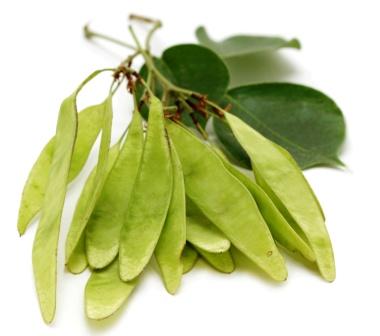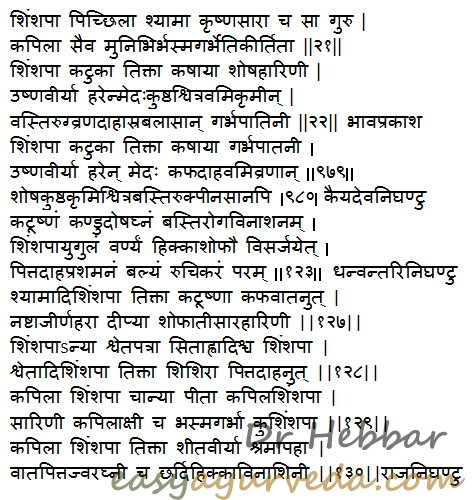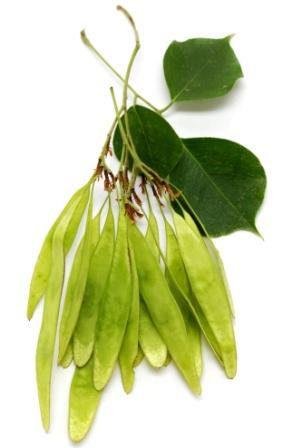Dalbergia sissoo: Shisham Tree Uses, Research, Side Effects
Dalbergia sissoo, Shisham or Shimshapa is used for the treatment of obesity, vitiligo, fever, non healing wounds, ulcers, intestinal parasites etc. It is also used as a toothbrush in many countries.
Botanical name- Dalbergia sissoo. Synonyms: Amerimnon sissoo (Roxb.) Kuntze, Amerimnon P.Browne Coroya Pierre Ecastaphyllum P.Browne Miscolobium Vogel
Family- Fabaceae (Pea family) (Simbi kula / Aparajita upakula)
Table of Contents
Vernacular names
Shisham tree – names in different languages:
Hindi name- Seesam, Sheesham
English name- Sissoo, Indian rosewood, North Indian Rosewood
Kannada name – Biridi
Gujarati name – Seesam
Telugu name- Irugudu, Shishupa
Tamil name – Kottakarantai
Manipuri name – Sissu, Sisu
Bengali name – Sitral, Shishu
Marathi name – Shishav
Punjabi name – Sharai
Sanskrit Synonyms
Vrutta patra, Mandalapatrika – circular leaves,
Bhasmagarbha, Krishnasara. Picchila.
Guru – Its wood is hard
Classical categorization
Shinshapa Classical Categorization
Charaka-
Kashaya skandha – astringent group of herbs
Asavayoni – source for herbal wines
Susruta– Salasaradi, Mushkakadi
Vagbhata– Asanadi,Mushkakadi
Bhavaprakasha Nighantu – Vatadi Varga
Kaiyadeva Nighantu – Oshadhi Varga
Dhanvantari Nighantu – Amradi Varga
Raja Nighantu – Prabhadradi Varga

Types, chemical constituents
As per Raja Nighantu – three types – Krushna (black), shweta (white), Kapila (gray).
Dalbergia latifolia is also used in the name of Shinshapa. (PV Sharma).
Dalbergia sissoo chemical Constituents
Leaves – Biochanin A, tectorigenin
Stem bark- Iso Tectorigenin,
Ethanolic extract of bark contains carbohydrates, proteins, amino acids, phenolic compounds, and flavonoids.
Heartwood- Dalberg Phenol, Delbergenone, Dalbergin, Methyl dalbergin (JLN Sastry)
Properties, part used, dosage
Shimshapa medicinal Properties
Guna (qualities) – Laghu – light to digest, Rooksha – Dryness
Rasa (taste) – Kashaya – astringent, Katu – pungent, Tikta – bitter
Vipaka- Katu – Undergoes pungent taste conversion after digestion
Veerya – Ushna – Hot potency
Effect on Tridosha – Balances Kapha and Vata
Part used: leaves, Sara (heartwood extract), bark, root
Dose –
kashaya – 50 – 100 ml in divided doses per day
Powder – 2 – 6 grams per day.
Sanskrit verse

Benefits, indications
Dalbergia sissoo health benefits:
Kaphahara – balances Kapha, useful in productive cough, asthma
Garbhapatini – induces abortion
Varnya – Improves skin tone and complexion
Indicated in –
Shosha – emaciation
Meda – obesity
Kushta – skin diseases
Shvitra – leucoderma, vitiligo
Vami – vomiting
Krumi – worm infestation
Vastiruk – lower abdominal pain, urinary tract disorders
Vrana – Ulcers, wounds
Daha – burning sensation, as in gastritis, neuropathy, burning sensation in eyes etc
Asra – blood disorders such as abscess, skin disorders, bleeding disorders such as menorrhagia, nasal bleeding etc.
Peenasa – rhinitis
Kandu – itching, pruritus
Hikka – hiccups
Shopha – inflammation

Decoction of leaves is used in the treatment of gonorrhea.
Wood is used for the treatment of leprosy, boils, and vomiting.
Bark is used for treating Vata disorders such as sciatica, hemiplegia.
Root is used for treating diarrhea, dysentery.
Heart wood is used for treating herpes, vitiligo, fever.
Shimshapa Sara ksheerapaka is indicated in treating fever (Sushruta)
Shisham taila – Its oil is applied externally to treat infested wounds, sinuses.
Leaf juice extract is used for treating secondary amenorrhea.
Its heartwood is useful in correction of lipid profile – lowering LDL and VLDL and increasing HDL.
Shyama Simsapa
The black variety of Shimshapa – Shyama Simsapa:
Tikta – bitter
Katu – pungent
Ushna – hot
Balances Kapha and Vata Dosha
Deepya – improves digestion strength
Indicated in –
Nashta Ajeerna – chronic indigestion
Shopha – inflammation
Atisara – diarrhea, dysentery
Sweta Sinshapa
Sweta Sinshapa – White variety – having white leaves –
Tikta – bitter
Shishira – coolant
Pittahara – useful in Pitta imbalance disorders such as gastritis, burning sensation, etc.
Indicated in –
Daha – burning sensation, as in gastritis, neuropathy, burning sensation in eyes etc
Kapila Shimshapa
Kapila Shimshapa – gray variety:
Abortifacient – induces abortion
Tikta – bitter
Sheeta – coolant
Shramahara – Relieves tiredness, fatigue
Indicated in –
Vatapittaja Jwara – fever with Vata and Pitta imbalance
Chardi – Vomiting
Hikka – hiccups
Side effects
Dalbergia sissoo side effects:
It is contraindicated during pregnancy.
Root is best avoided during constipation.
Leaf juice extract is contraindicated during heavy periods.
Interaction with medicines, supplements
Can this be used while taking Homeopathic medicine?
Yes. This product does not react with homeopathic medicine.
Can this medicine be continued while taking supplements like multivitamin tablets, Omega 3 fatty acids etc?
Yes. Generally, this product goes well with most dietary supplements. However, if you are taking more than one product per day, please consult your doctor for an opinion.
With western
medicines
Seek your
doctor’s advice if you are taking this product along with other western
(allopathic / modern) medicines. Some Ayurvedic herbs can interact with modern
medicine.
If both Ayurvedic and allopathic medicines are advised together, then it is
best to take Allopathic medicine first, wait for 30 minutes and then take the
Ayurvedic medicine.
Ayurvedic medicines
Ayurvedic medicines with Dalbergia sissoo as ingredient:
Click on the medicine name to know more about it.
Ayaskriti – used in anemia, weight loss therapy, skin diseases etc.
Asanadi Kashayam – It is used in the treatment of diabetes, skin diseases and obesity etc.
Narasimha Rasayana – medicine for the treatment of weakness, weight gain, hair growth and rejuvenation.
Morphology
Tall tree with numerous branches.
Leaves – Compound, alternate, imparipinnate
Inflorescence – Axillary panicle
Flowers – Sessile, pale yellow in colour
Fruits – Pods
Seeds – 1 – 4 in number
Substitute
Dalbergia latifolia
Research
Antinociceptive activity of ethanolic extract of bark was investigated by the Department of Pharmacy, Faculty of Pharmacy, GRD (PG) IMT Rajpur, Dehradun. Tail flick method was adopted on Wistar rats. Three different dose levels (300, 500, and 1000 mg/kg) in 0.5% carboxymethylcellulose (CMC) were administered by p.o. route. The antinociceptive activities of the all doses were compared with that of the standard drug asprin (300 mg/kg). The results were found to be significant (P < 0.01). The antinociceptive activity of the bark extract of D. sissoo may be due to the presence of phytochemical constituents such as flavonoids. The acute toxicity study revealed that ethanolic extract was not toxic up to 3000 mg/kg body weight.
Anti-diabetic activity was evaluated by 1 Department of Pharmacology, AISSMS College and MGV’s College of Pharmacy, Panchavati, Nashik. In the present study, the antidiabetic effect of ethanolic extract of bark was investigated in alloxan (AL) induced diabetic rats. Oral administration of doses of 250 and 500 mg/kg was studied. The two doses caused significant reduction in blood glucose levels in all the models. The effect was more pronounced in 500 mg/kg than 250 mg/kg. D.Sissoo also showed significant increase in body weight and glycogen content in the liver of AL-induced diabetic rats while there was significant reduction in the levels of serum triglyceride and total cholesterol. DS also showed significant improvement in the pancreas of AL-induced diabetic rats. The antidiabetic effect of D.Sisso was compared with glibenclamide, a well-known hypoglycemic drug. The results indicate that ethanolic extract of Dalbergia sissoo bark possesses significant anti-diabetic activity.
Potential for cancer treatment:
Compounds obtained from D. sissoo like an isoflavone, biochanin is a potent chemotherapeutic cancer preventive agent. (1)
Sthanika karma (Action on different system)
External application – Anthelmintic, it helps to cleanses the wound. Leaf juice is good for eye disorders. Indicated in skin diseases, Non healing ulcers etc.
Nervous system – Strengthens the nervous system. Bark is indicated in Sciatica etc.
Digestive system – Root has absorbent property and is indicated in Diarrhea and Dysentery. Leaf has Carminative and absorbent action, it facilitates normal movement of vata dosha. It is indicated in loss of appetite, Abdominal colic, Bloody diarrhea, vomiting, Hemorrhoids, etc. Heart wood has Anthelmintic action.
Circulatory System – Heartwood is indicated in Rheumatoid arthritis, STDs (Syphilis) etc.
Reproductive system – Heartwood helps to contract the uterine muscles. Induce menstruation. Leaf juice has Styptic action and is indicated in Menorrhagia
Respiratory system – Pacifies kaphadosha. Indicated in Hiccough and Asthma.
Excretory system – Leaf has the quality of increasing the urine production. Leaf juice is indicated in UTI , Hematuria etc. (Puyameha, Lalameha). In Vasameha Heartwood is used
Satmikarana – Heartwood is indicated in Obesity and Leaf juice is beneficial in Anemia.
Skin – Bark powder is Indicated in skin disorders (kushta, visarpa, switra)
Tapakrama – Heartwood decoction is indicated in Fever (Antipyretic)











13 comments
DR P JAFFAR ALI KHAN
You are giving very good, useful and detailed information on the medicinal plants.
Will you kindly post an article on Qust shiri or Costus indicus?
Dr J V Hebbar MD(Ayu)Author
Dear Dr Jaffer, thanks for the compliment. Are you referring to this herb – https://www.easyayurveda.com/2013/09/19/kushta-saussurea-lappa-benefits-usage-dose-side-effects/ ?
Karan
Can we eat as many leaves of sheesham as we like? And can we eat as many curry leaves as I wish because I like their pungent taste a lot. What will be benefits and losses if I ate more leaves out of taste. I love eating green new curry leaves.
Dr J V Hebbar MD(Ayu)Author
There are no known side effects with over eating them. Better to restrict to 10 grams per day.
Karan
Sir could you tell me that 10 gram is approx how many leaves? Thank You.
Dr J V Hebbar MD(Ayu)Author
I honestly do not know. About 4 – 5 leaves?
Kamlesh L Thakor
Sir, the leaves of sheesham is useful in treatment of Cancer , so many massages are spread over media , please tell me what is the truth ,
Dr J V Hebbar MD(Ayu)Author
Dear sir, there are no hard evidence for its usage against cancer, as per my knowledge.
Joneja
Namaste doc Recently i bought sheesham leaves powder but i dnt know how to use it. I cant even find on YouTube how to use.can u pls help me. Thanks
s K Gupta
Sir Is sheeshsm leafs useful in urinary track infection.
Dr J V Hebbar MD(Ayu)Author
Not to a great extent.
Dhiren Shah
Is sheesham juice use to cure in asthama
Dr J V Hebbar MD(Ayu)Author
Yes, useful.